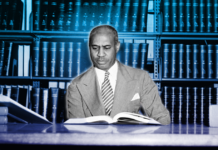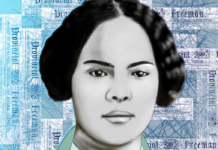As a Black homeschooling mom, I am most irritated by the mere thought of my children being trapped in a failing school. But there are a couple of recent misconceptions about Black homeschooling families that have also been getting on my nerves.
First, the media attention to Black homeschooling portrays us as an anomaly. Our numbers began increasing well before the pandemic, and since then have skyrocketed. Black homeschoolers are not eccentric. We share many of the same concerns and values as our fellow Black families who have chosen public schooling.
WE BLACK HOMESCHOOLERS ARE EXPRESSING OUR RIGHT TO SELF-DETERMINATION, WHICH HAS DEEP HISTORICAL ROOTS.
The second misconception is that Black homeschoolers are turning their backs on the legacy of Brown v. Board of Education. We are not here to re-segregate children. We Black homeschoolers are expressing our right to self-determination, which has deep historical roots.
When No One Else Could or Would Teach Us, We Taught Ourselves
Black homeschoolers have always existed. We taught our own children when there were no formal schools and when they couldn’t attend schools. When no one would or could teach us in formal schooling, we found other ways to learn.
Take the example of Frederick Douglass, who learned to read in secret as a young enslaved person. When his mistress was told to stop teaching him reading, he gave bread to young white boys to tutor him and continue his learning. As a free adult and a father, he chose to have his young daughter privately tutored before pushing to desegregate the public schools in Rochester, New York—about a century before the Brown decision.
Contrast these historical experiences with the current experiences of too many children in modern public schools: mistaught when learning to read, locked into—or out of—special education, viewed as angry and disproportionately disciplined. The fear of mistreatment in public school is a factor often considered by many Black homeschooling families.
CHILDREN SHOULD NOT BE EXPECTED TO LEARN AND THRIVE IN ENVIRONMENTS WHERE THEY ARE NOT WELCOMED, PROPERLY TAUGHT OR EVEN GIVEN BASIC RESPECT.
Children should not be expected to learn and thrive in environments where they are not welcomed, properly taught or even given basic respect. Removing children from those types of environments often becomes a matter of sanctuary and protection, not a recreation of the segregation of the past.
When We Fought for Integration, We Still Had to Learn on Our Own
Parents’ fears are not unfounded. History shows us this—and shows Black families’ response to government efforts to deny their children education—in the experiences of the Little Rock Nine, the nine Black high school students who volunteered to desegregate Little Rock’s Central High School.
The Supreme Court’s decision in favor of integrated schools did not immediately persuade state and local governments into compliance. Three years after the Brown decision, segregationists forced President Eisenhower to issue an executive order that brought the United States Army to protect the Little Rock Nine from life-threatening violence at Central High.
Let’s also not forget that only one of the Little Rock Nine—Ernest Green—actually graduated from Central High at the end of their harrowing year. Subsequently, the other eight students were prevented from attending any local public high school when Arkansas Governor Orval Faubus closed all of Little Rock’s high schools for an entire year.
BLACK STUDENTS AND THEIR FAMILIES MADE A WAY OUT OF NO WAY BY EDUCATING THEMSELVES OUTSIDE THEIR LOCAL PUBLIC SCHOOLS.
What happened then? Those eight students continued their high school educations at home, via correspondence classes, or at public and private schools beyond Arkansas. Once again, Black students and their families made a way out of no way by educating themselves outside their local public schools.
What about our children today, who face relentless discrimination at school without armed troops to protect them?
Instead of holding Brown v. Board of Education over our heads, we should learn from the impact it has had and move forward. De facto segregation persists today and the forced integration of generations of children has not produced the desired results: high academic and social-emotional outcomes.
While Courts and Lawmakers Waffle, We Will Chart Our Own Course
Years later, the Supreme Court made another decision that took much of the teeth out of Brown. The decision in San Antonio Independent School District v. Rodriguez doesn’t get as much publicity as Brown v. Board, but it should. In this case, the Court held that the state of Texas had no obligation to provide equitable funding to all the districts in the state. While the Brown case established a right to educational equity, the Rodriguez case essentially overruled Brown and found no such right to be guaranteed by the U.S. Constitution.
Justice Thurgood Marshall, previously an NAACP attorney in the Brown case, dissented in the Rodriguez case. He recognized the reversal and aftermath by the majority opinion holders and said:
In my judgment, the right of every American to an equal start in life, so far as the provision of a state service as important as education is concerned, is far too vital to permit state discrimination on grounds as tenuous as those presented by this record. Nor can I accept the notion that it is sufficient to remit these appellees to the vagaries of the political process which, contrary to the majority’s suggestion, has proved singularly unsuited to the task of providing a remedy for this discrimination. I, for one, am unsatisfied with the hope of an ultimate ‘political’ solution sometime in the indefinite future while, in the meantime, countless children unjustifiably receive inferior educations that ‘may affect their hearts and minds in a way unlikely ever to be undone.’ Brown v. Board of Education, 347 U.S. 483, 494 (1954). I must therefore respectfully dissent.
Lawmakers and courts continue to debate the issue of what constitutes educational equity, while states across the nation continue to allow majority-white school districts to hoard $23 billion. In the midst of this chaos, Black parents must assert self-determination for their families.
Self-determination means we must choose to do what’s best for our children and families while also advocating for long-term justice and equity for everyone. Our pursuit of civil rights in education didn’t end with Brown, and our children cannot wait for the goodwill and desire of the system to make sure they learn and thrive.










